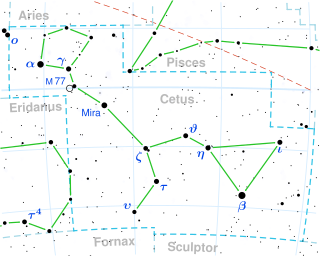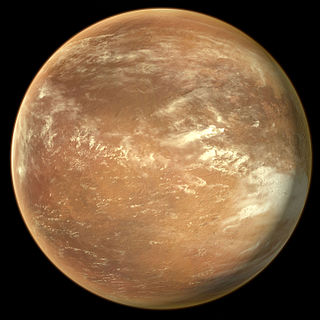
Tau Ceti, Latinized from τ Ceti, is a single star in the constellation Cetus that is spectrally similar to the Sun, although it has only about 78% of the Sun's mass. At a distance of just under 12 light-years from the Solar System, it is a relatively nearby star and the closest solitary G-class star. The star appears stable, with little stellar variation, and is metal-deficient relative to the Sun.

HD 219134 is a main-sequence star in the constellation of Cassiopeia. It is smaller and less luminous than the Sun, with a spectral class of K3V, which makes it an orange-hued star. HD 219134 is relatively close to our system, with an estimated distance of 21.34 light years. This star is close to the limit of apparent magnitude that can still be seen by the unaided eye. The limit is considered to be magnitude 6 for most observers. This star has a magnitude 9.4 optical companion at an angular separation of 106.6 arcseconds.

Gliese 581d is a doubtful, and frequently disputed, exoplanet candidate orbiting within the Gliese 581 system, approximately 20.4 light-years away in the Libra constellation. It was the third planet claimed in the system and the fourth or fifth in order from the star. Multiple subsequent studies found that the planetary signal in fact originates from stellar activity, and thus the planet does not exist, but this remains disputed.
HD 85512 is a solitary K-type main-sequence star 36.8 light-years away in the constellation Vela. It is about 1 billion years older than the Sun. It is extremely chromospherically inactive, only slightly more active than Tau Ceti. It exhibits a long-term variability and was thought to host one low-mass planet, although this is now doubtful.
Gliese 433 is a dim red dwarf star with multiple exoplanetary companions, located in the equatorial constellation of Hydra. The system is located at a distance of 29.6 light-years from the Sun based on parallax measurements, and it is receding with a radial velocity of +18 km/s. Based on its motion through space, this is an old disk star. It is too faint to be viewed with the naked eye, having an apparent visual magnitude of 9.81 and an absolute magnitude of 10.07.

HD 40307 g is an exoplanet candidate suspected to be orbiting in the habitable zone of HD 40307. It is located 42 light-years away in the direction of the southern constellation Pictor. The planet was discovered by the radial velocity method, using the European Southern Observatory's HARPS apparatus by a team of astronomers led by Mikko Tuomi at the University of Hertfordshire and Guillem Anglada-Escude of the University of Göttingen, Germany.

HD 40307 e is an extrasolar planet candidate suspected to be orbiting the star HD 40307. It is located 42 light-years away in the direction of the southern constellation Pictor. The planet was discovered by the radial velocity method, using the European Southern Observatory's HARPS apparatus by a team of astronomers led by Mikko Tuomi at the University of Hertfordshire and Guillem Anglada-Escude of the University of Göttingen, Germany.
HD 40307 f is an extrasolar planet orbiting the star HD 40307. It is located 42 light-years away in the direction of the southern constellation Pictor. The planet was discovered by the radial velocity method, using the European Southern Observatory's HARPS apparatus by a team of astronomers led by Mikko Tuomi at the University of Hertfordshire and Guillem Anglada-Escude of the University of Göttingen, Germany. The existence of planet was confirmed in 2015.
Gliese 180, is a small red dwarf star in the equatorial constellation of Eridanus. It is invisible to the naked eye with an apparent visual magnitude of 10.9. The star is located at a distance of 39 light years from the Sun based on parallax, and is drifting closer with a radial velocity of −14.6 km/s. It has a high proper motion, traversing the sky at the rate of 0.765 arcseconds per year.
Mikko Tuomi is a Finnish astronomer from the University of Hertfordshire, most known for his contributions to the discovery of a number of exoplanets, among them the Proxima Centauri b which orbits the closest star to the Sun. Mikko Tuomi was the first to find indications of the existence of Proxima Centauri b in archival observation data. Other exoplanets to whose discovery or study Tuomi has contributed include HD 40307, HD 154857 c, Kapteyn c, Gliese 682 c, HD 154857, Gliese 221, Gliese 581 g and the planetary system orbiting Tau Ceti. He has led the development of new data analysis techniques for distinguishing observations caused by natural activity of the star and those caused by planets orbiting them.
Tau Ceti f is a confirmed exoplanet that is a potential super-Earth or mini-Neptune orbiting Tau Ceti that was discovered in 2012 by statistical analyses of the star's variations in radial velocity, based on data obtained using HIRES, AAPS, and HARPS. It is of interest because its orbit places it in Tau Ceti's extended habitable zone, but a 2015 study implies that there may not be a detectable biosignature because it has only been in the temperate zone for less than one billion years. In 2017, it was again recovered from radial-velocity data, along with Tau Ceti e.





